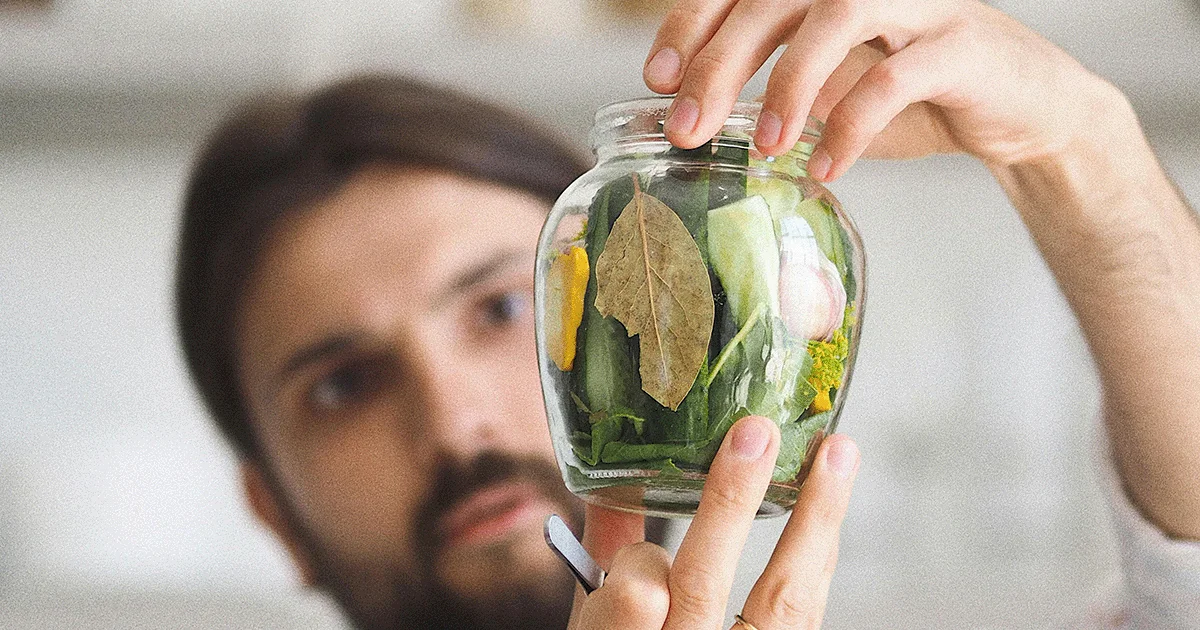Here's what we'll cover
Here's what we'll cover
Nicknamed the sunshine vitamin, you might think the majority of vitamin D we get comes from the sun. However, vitamin D deficiency is a more common problem than we may think. Around four in 10 people living in the US have a vitamin D deficiency. People who have reduced sun exposure, like those living farther away from the equator, nursing home residents, and healthcare workers, are especially at risk of not getting enough (Forrest, 2011).
And while sunshine might be a solid source of vitamin D, it’s not an ideal option. Too much exposure to the sun’s ultraviolet rays increases the risk of developing skin cancer. That’s why healthcare professionals recommend that you get your vitamin D from food. Egg yolks, tuna, red meat, and fortified milk are all examples of foods rich in vitamin D.
One glass of fortified cow’s milk gives us around 15–20% of our recommended daily vitamin D allowance. Foods like milk and cereal don’t contain vitamin D naturally, so the nutrient is added by manufacturers to help people stay healthy. Here’s more on what you need to know about vitamin D, milk, and your diet.
Why is vitamin D added to milk?
We probably all learned at some point that sunlight is a natural source of vitamin D. And it may be the primary source, with studies estimating that people get roughly 80% of their vitamin D intake from sunlight (Wimalawansa, 2017).
It's not as reliable a source today though, as people generally spend less time inside and the risks associated with excessive sun exposure means it's a less practical way to get your daily dose of vitamin D (Cashman, 2019).
So how does food fit in? Back in the 1930s, people discovered that adding vitamin D to common foods like cereal and milk could improve public health. Most notably, fewer children had rickets—a condition of weak and deformed bones caused by low vitamin D intake (Hernigou, 2019).
Adding vitamin D to milk has other benefits, too. Milk is rich in calcium, but our bodies can’t absorb it without the help of vitamin D. Adding it to milk during processing ensures we’re getting vitamin D and enables calcium absorption for strong bones.
How much vitamin D does milk have?
Each serving of milk fortified with vitamin D has at least 100 IU (or 2.5 mcg) per 8 oz serving (roughly one cup). How much is that exactly? The average healthy adult needs about 600 IU of vitamin D each day to stay healthy, and an 8 oz serving is roughly 15-20% of the daily requirement.
The best way to see how much vitamin D is in a bottle of milk is to check the nutrition label (ODS, 2020).
Here are some common brands of milk and how much vitamin D they have:
Horizon Organic Whole or Fat-Free Milk: 4.5 mcg (180 IU) of vitamin D
Stonyfield Organic Whole Milk: 3 mcg (120 IU) of vitamin D
Lactaid Fat-Free Milk: 2.5 mcg (100 IU) of vitamin D
Borden Lactose-Free 2% Reduced Fat Milk: 2.5 mcg (100 IU) of vitamin D
How much daily vitamin D do I need?
Vitamin D is an essential nutrient that supports strong bones, nerves, and muscles (Sizar, 2020). The amount of vitamin D you need each day depends both on your age and whether you have adequate vitamin D levels to begin with.
As we noted earlier, the recommendation for most adults is 600 IU of vitamin D per day. For those ages 70 years and older, the recommendation is 800 IU (ODS, 2020). People with a vitamin D deficiency, however, need higher amounts.
How do I know if I’m getting enough vitamin D?
The best way to know your vitamin D levels is to get your blood taken. Not everyone needs to get their vitamin D levels checked regularly, but it may be a good idea if you’re experiencing symptoms of a deficiency. Here are the common ranges:

Some common signs and symptoms of low vitamin D include (Sizar, 2020):
Bone pain
Depressed mood
Fatigue
Muscle weakness
Certain individuals, such as those with chronic kidney disease or inflammatory bowel disease, are at higher risk of being vitamin D deficient (Sizar, 2020). People with low vitamin D levels need to take a high-dose supplement, while those without a deficiency can usually maintain vitamin D levels through a healthy diet (Holick, 2011).
What other food products have vitamin D?
As we’ve highlighted already, milk is an excellent source of vitamin D. It’s also affordable, accessible, and full of other nutrients as well, such as calcium.
Since each serving of milk only contains about 100 to 180 IU of vitamin D, you’ll probably need additional food sources to meet the daily recommended 600-800 IU intake (Holick, 2011).
Experts agree a varied diet rich in foods with vitamin D is the best way to ensure you’re meeting the daily requirement. Here are some everyday food products and how much vitamin D each contains (ODS, 2020):
Cod liver oil, one tablespoon: 1,360 IU
Salmon (sockeye), cooked, three ounces: 570 IU
Trout (rainbow), farmed, cooked, three ounces: 645 IU
Mushrooms, white, raw, sliced, exposed to UV light, ½ cup: 366 IU
Egg, one large, with yolk: 44 IU
Liver, beef, braised, three ounces: 42 IU
Tuna fish (light), canned in water, drained, three ounces: 40 IU
Sardines (Atlantic), canned in oil, drained, two sardines: 46 IU
Cheese, cheddar, one ounce: 12 IU
Ready-to-eat cereal fortified with vitamin D, one serving: 8 IU
Do I need vitamin D supplements in addition to eating high vitamin D foods?
That depends on how much vitamin D you are getting from your food.
If you’re vegan, vegetarian, or someone who doesn’t regularly eat dairy products or fatty fish, it may be difficult for you to hit your daily recommended allowance. In that case, you may want to explore vitamin D supplements.
Vitamin D supplements come in two forms: D2 and D3. Each is a type of vitamin D, just from a different source. Vitamin D2 comes from plant products, and D3 is commonly from fatty fish like salmon or tuna. You’re more likely to see vitamin D3 as a supplement as it’s more effective at upping vitamin D levels than D2 (Tripkovic, 2017).
Available over-the-counter vitamin D3 supplements come in various doses, including 400 IU, 800 IU, 1000 IU, and 2000 IU.
Is it possible to take too much vitamin D?
Although rare, it’s possible to get too much vitamin D. For healthy adults, this typically only happens if you take excessive quantities of high-dose supplements without having your blood levels monitored (Asif, 2020).
Side effects of too much vitamin D include nausea, vomiting, muscle pain, and frequent urination (Sizar, 2020). Staying under the daily maximum limit of 4,000 IU vitamin D will avoid the risk of toxicity (ODS, 2021).
If you aren’t getting all the vitamin D you need through your diet, vitamin D3 supplements can help you get that extra vitamin D boost for optimal bone and muscle health.
DISCLAIMER
If you have any medical questions or concerns, please talk to your healthcare provider. The articles on Health Guide are underpinned by peer-reviewed research and information drawn from medical societies and governmental agencies. However, they are not a substitute for professional medical advice, diagnosis, or treatment.
Asif A, Farooq N. (2020). Vitamin D toxicity. StatPearls. Retrieved on Mar 29, 2021 from https://pubmed.ncbi.nlm.nih.gov/32491799/
Cashman K. D. (2020). Vitamin D Deficiency: Defining, Prevalence, Causes, and Strategies of Addressing. Calcified Tissue International, 106 (1), 14–29. doi: 10.1007/s00223-019-00559-4. Retrieved from https://pubmed.ncbi.nlm.nih.gov/31069443/
Forrest, K. Y., & Stuhldreher, W. L. (2011). Prevalence and correlates of vitamin D deficiency in US adults. Nutrition Research, 31 (1), 48–54. doi: 10.1016/j.nutres.2010.12.001. Retrieved from https://pubmed.ncbi.nlm.nih.gov/21310306/
Holick MF, Binkley NC, Bischoff-Ferrari HA, Gordon CM, Hanley DA, Heaney RP, Murad MH, Weaver CM., Endocrine Society. (2011). Evaluation, treatment, and prevention of vitamin D deficiency: an Endocrine Society clinical practice guideline. Journal of Clinical Endocrinology and Metabolism, 96 (7), 1911-30. doi: 10.1210/jc.2011-0385. Retrieved from https://pubmed.ncbi.nlm.nih.gov/21646368/
Hernigou, P., Auregan, J. C., & Dubory, A. (2019). Vitamin D: part II; cod liver oil, ultraviolet radiation, and eradication of rickets. International Orthopaedics, 43 (3), 735–749. doi: 10.1007/s00264-019-04288-z. Retrieved from https://pubmed.ncbi.nlm.nih.gov/30627846/
Office of Dietary Supplements (ODS). (January, 2021). Vitamin D Fact Sheet for Consumers. NIH. Retrieved on February 8, 2021 from https://ods.od.nih.gov/factsheets/VitaminD-Consumer/
Office of Dietary Supplements (ODS). (October, 2020). Vitamin D Fact Sheet for Health Professionals. NIH. Retrieved on February 16, 2021 from https://ods.od.nih.gov/factsheets/VitaminD-HealthProfessional
Sizar O, Khare S, Goyal A, et al. (2020). Vitamin D Deficiency. StatPearls. Retrieved on Feb 1, 2021 from https://www.ncbi.nlm.nih.gov/books/NBK532266/
Tripkovic, L., Wilson, L. R., Hart, K., Johnsen, S., de Lusignan, S., Smith, C. P., et al. (2017). Daily supplementation with 15 μg vitamin D2 compared with vitamin D3 to increase wintertime 25-hydroxyvitamin D status in healthy South Asian and white European women: a 12-wk randomized, placebo-controlled food-fortification trial. The American Journal of Clinical Nutrition, 106 (2), 481–490. doi: 10.3945/ajcn.116.138693. Retrieved from https://pubmed.ncbi.nlm.nih.gov/28679555/
Wimalawansa, S. J., Razzaque, M. S., & Al-Daghri, N. M. (2018). Calcium and vitamin D in human health: Hype or real?. The Journal of Steroid Biochemistry and Molecular Biology, 180 , 4–14. doi: 10.1016/j.jsbmb.2017.12.009. Retrieved from https://pubmed.ncbi.nlm.nih.gov/29258769/










